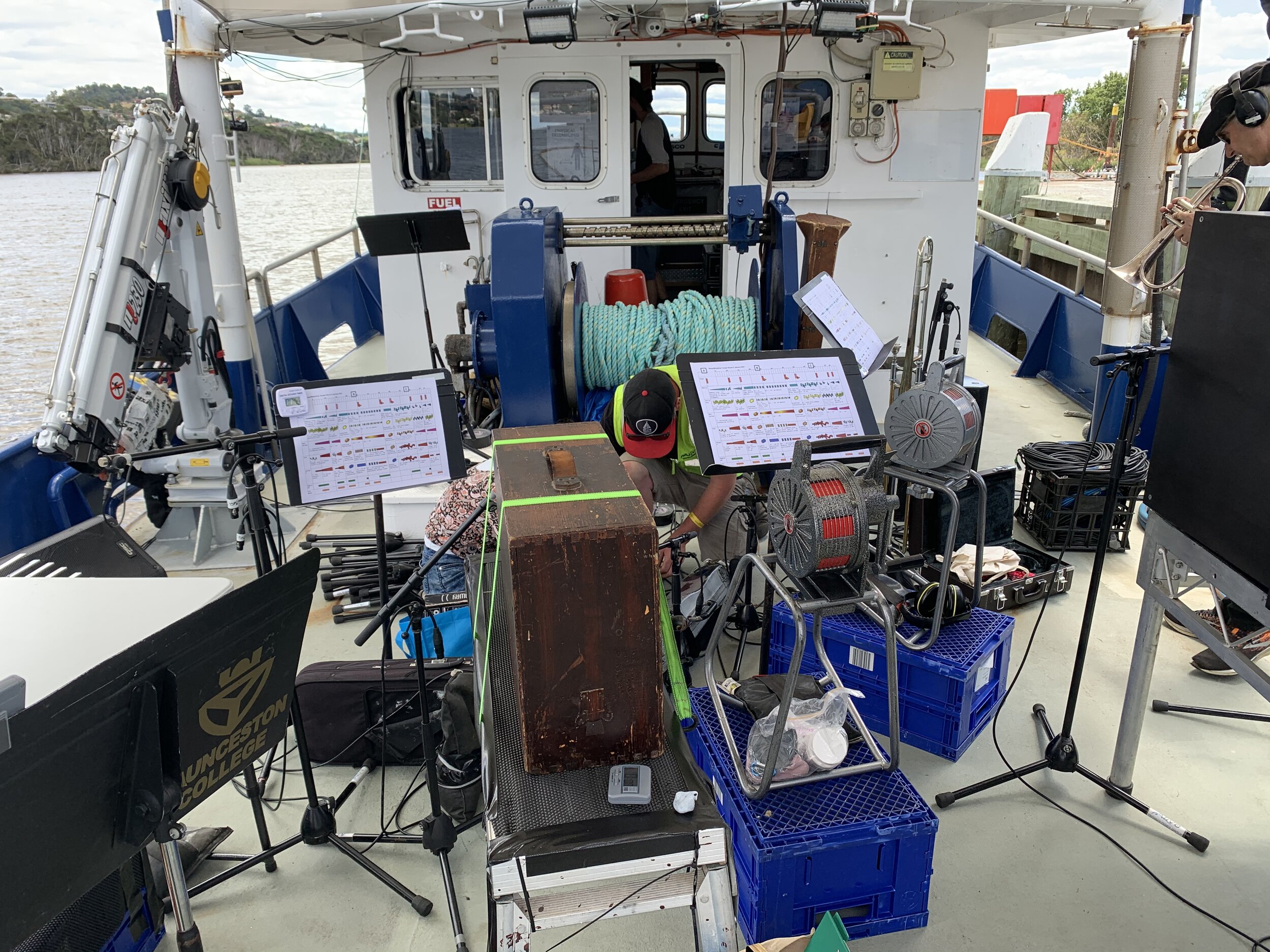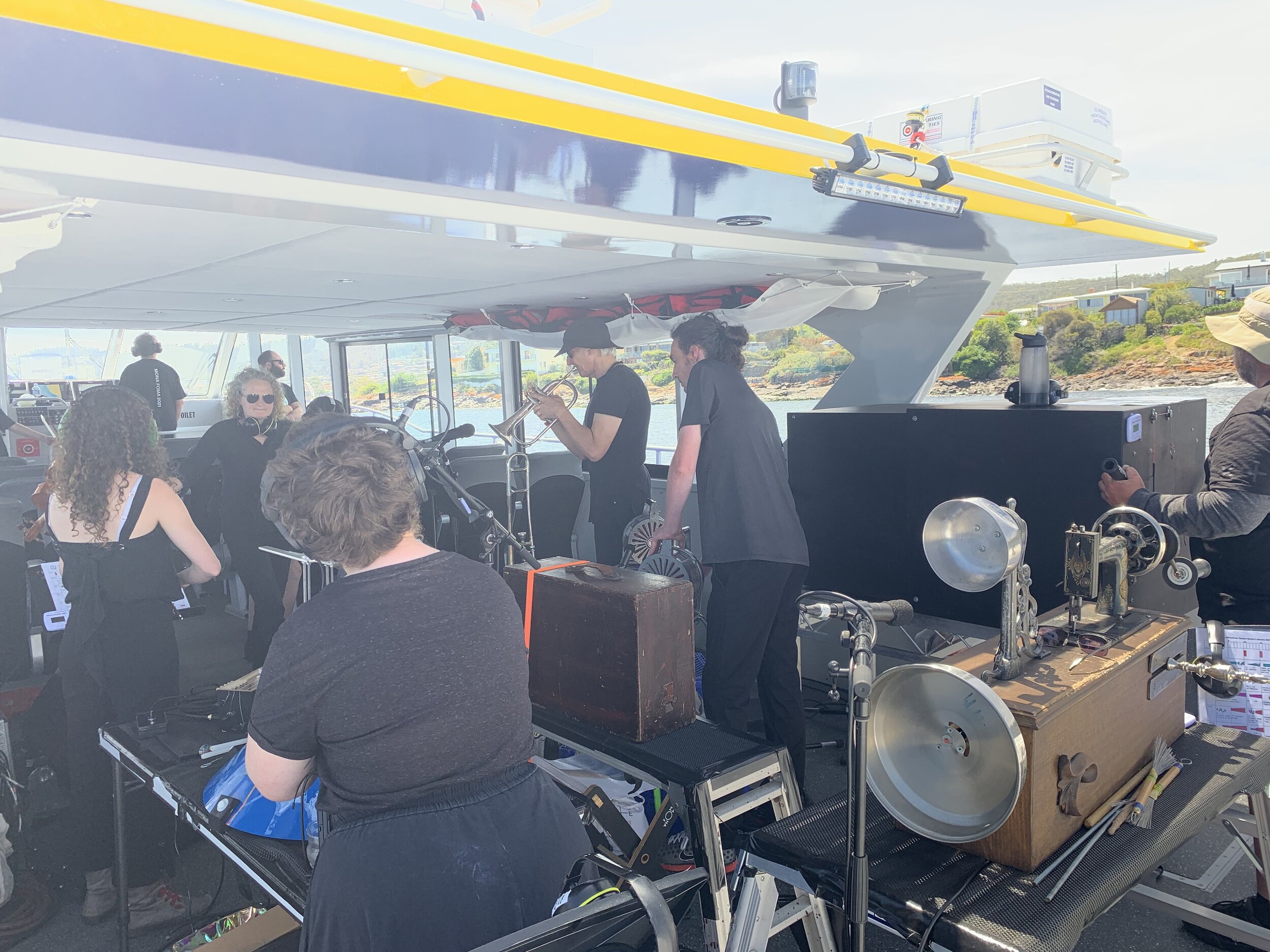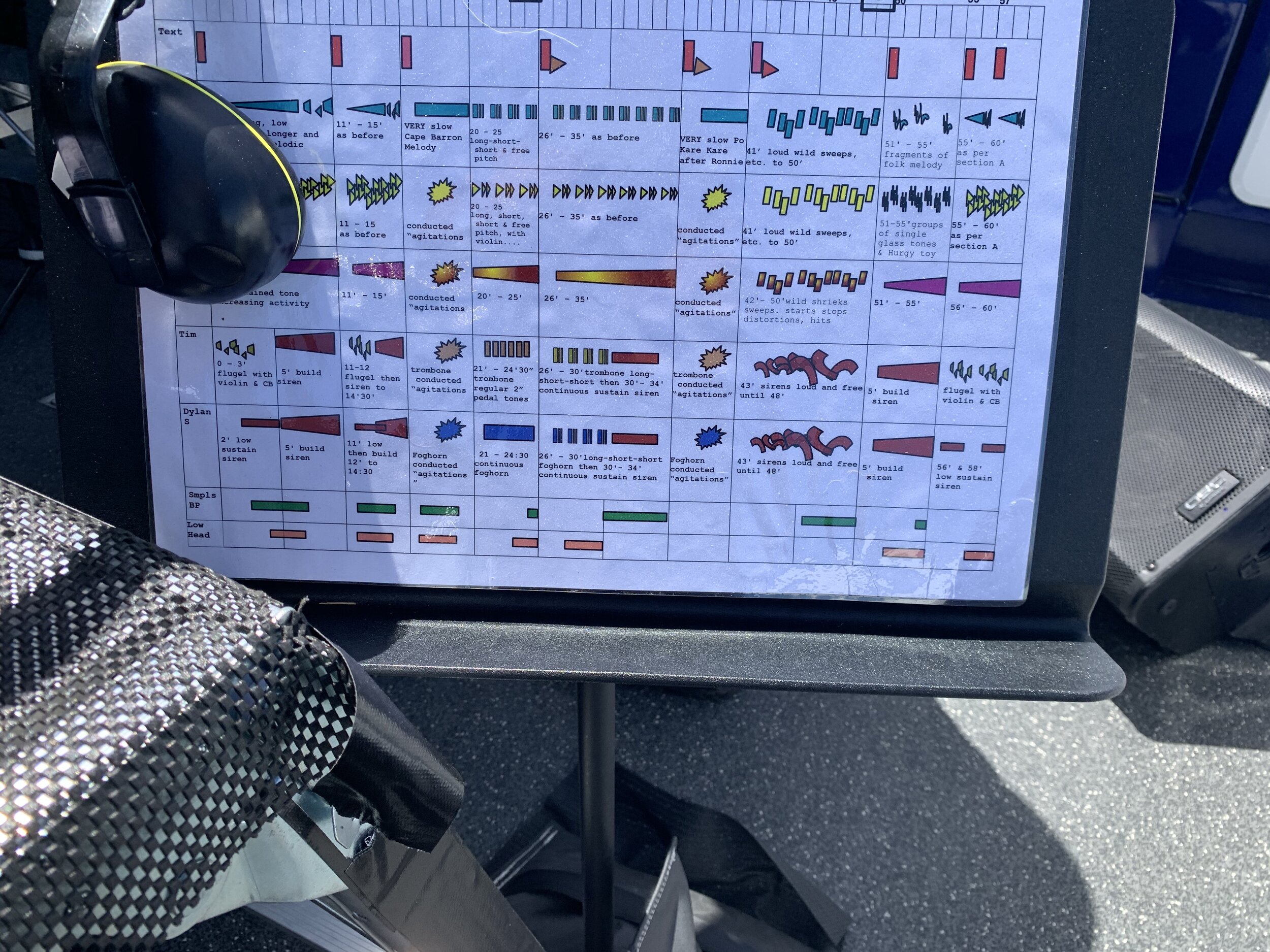
Recent Works
relay//country remembers her names
Feeling very lucky to be involved in this recent festival project. Link to website at the bottom of the post. There is a lot to this one! The short version: Under the guidance of Composer Madeleine Flynn myself and 6 other musicians performed a beautiful work on two different rivers in my home state of Tasmania during the MONA FOMA 2021 festival. The instrumentation included horns, strings, sirens/fog horns, intonarumori and many other sound and trad instruments as well as a beautiful and moving text from Theresa Saintly. Here is a small summary from the program guide….
Relay / Country Remembers Her Names
Madeleine Flynn, Tim Humphrey with Theresa Sainty
A slowly unfolding relay of land and sea signals echoes across our fair island, opening and closing the festival. Foghorns streamed from Low Head, boat horns, sirens, experimental intonarumori instruments, palawa kani (the language of Tasmanian Aboriginal people), bagpipe streamed from Queenstown, and other sound-making apparatus call each other over land and water, and ask us to reflect on where we are. From wukalina / Mount William and pilawaytakinta / Low Head, to Queenstown, Launceston and nipaluna / Hobart.
You will hear the work projected from a moving vessel meandering close to shore. In Launceston, listen from the banks of kanamaluka / Tamar River around Riverbend Park, Royal Park and Seaport. In Hobart, listen from the banks of the Derwent around the Hobart foreshore, to Long Beach, Sandy Bay, and on the eastern shore between Howrah and Bellerive.
Below is a small section of one of the performances
Personal
Created by Madeleine Flynn and Tim Humphrey with Theresa Sainty.
Collaborators: Zoe Rimmer, Merinda Sainty, Tasmanian Aboriginal Centre, Ron & Zanette Crowden - Foghorn Volunteers Low Head Pilot Station Support Group, Andrew Bell, Rona Hollingsworth and Mike Webb and the Maritime Museum of Tasmania
Band: Mat Ward, Julia Drouhin, Dylan Sheridan, Dylan Banks, Phillipa Stafford, Emily Sheppard,
Remote site managers: Dan Rawlins, Chris Burton
Vessels and crew provided by the Australian Maritime College and Pennicott Wilderness Journeys.
Produced by Alison Wilkes and Bureau of Works
Technical manager Tom 'Billy' McKeand
Production support Rory Cadman
Videography Gabe Commerford



There is a wealth of detailed information about this project on the relay website. The project encompassed not just live music but pre-recorded indigenous poetry, live streamed instruments and sounds from across the state of Tasmania. The music reverberated off the hills of Hobart and Launceston as the vessels slowly meandered down the rivers creating a work that spoke to and incorporated the country it was written for. There are interviews, video link, translations of text and much more in the link below.
Boatcam - Hobart performance relay//country remembers her names MONA FOMA 2021
Dance of The Deserted Spaces
Dance of the Deserted Spaces is composed using field recordings taken from four different locations across the globe after the Covid-19 outbreak resulted in mass public lockdowns. The sonic character of these places shifted dramatically once stripped of the dominance of human activity and previously hidden aural worlds built from nature, automated machinery, the reverberation of open space and the earth itself revealed themselves.
The piece takes these ‘background’ sounds and give them a stage of their own to dance, converse, expand and exist independent from their relationship to human presence. These normally unregistered noises evolve rhythmically and harmonically in an autonomous celebration
of sound itself.
The idea developed from my last night on duty at the museum I work for in Tasmania, Australia. With the museum suddenly closed indefinitely to the public I walked from gallery to gallery shutting down all but the most basic power and lighting systems and listened as the empty
building revealed a new sonic atmosphere of gentle creaks, air-conditioning and essential plant mechanics. There was a sense of spirit emitting from the vacant architecture and the ever working
but unchampioned infrastructure the allowed these places to be habitable.
The sounds of the museum were recorded that night and form the raw material for Dance of the Deserted Spaces along with field recordings sent to me from a deserted intersection in Brooklyn, the empty auditorium of an international school in Yokohama and the entrance to the Parc des Buttes-Chaumont in Paris.
Ideas of dystopia, harmony, freedom, tension and evolution are explored as the global sounds come together in defiance of cultural classification, revelling in the peopleless space and time.
Life and energy beyond the reductive parameters of humanity and society are given a platform to create a celebratory noisescape of the omnipresent sounds the secretly surround us
The Smiling Madame Beudet
New Expanded Cinema performance from Dani Kirby/Mat Ward. Premiered 22nd January 2021 at MONA FOMA festival Hobart, Tasmania.
Kirby/Ward present the the latest chapter in their ongoing investigation both the history of sound in the era of silent cinema and the pioneering role female artists played (most often overlooked) in the avant garde.
The Smiling Madame Beudet is credited as the first Feminist movie. The protagonist Madame Beudet is trapped in a suffocating marriage with her only escape being music and the fantasy that she lives in a different world. Her husband is domineering, boorish and frequently pretends to shoot himself (sometimes in front of guests) to taunt and belittle her. Far from portraying Madame Beudet as a victim it casts her as a heroine who, rather than submitting to a life of cruelty, seeks to assert her desires and free herself from the bonds of domestic misogyny.
Dulac uses groundbreaking cinematic artistry to embellish and add detail to both the narrative and the investigation of sexism and gendered roles through techniques such as super-imposition, ultra contrasting of focus, slow-motion, repetition of shots, abstraction and extreme camera angles. These techniques powerfully enforce the Dulac’s desire to show both the oppressiveness of the situation and the absolute need for an imagining of a better life.
The compositional approach focuses on highlighting the sub-text and philosophical underpinnings of the film with emphasis on the meta-narrative behind the protoganist’s story - which is a timeless critique of marriage, gender and sexism. Cinematically this is expressed through Dulac’s focus on Madame Beduet’s internal world as she moves between the disparity of escapism and reality. It is her complex voice and thoughts, as a metaphor for the broader issues of the film that Kirby/Ward bring to life through a dynamic score that incorporates multiple genres ranging from ultra minimalist melody all the way to deafening sub-bass drone.
A Trip to the Moon
As part of the 2020 Unconformity Festival based in Queenstown Tasmania Dani Kirby and I, along with 8 artists from around the globe were asked to re-score a collection of old Sci-Fi movies as part of Unconformity's UNTV live night. Naturally enough all festival activities were via the Internet this year and the show was broadcast on October 17th 2020 There is almost no info about the 1926 film Dani and I were given other than the year it was made. I cant even find any info on the production company etc. Its called Trip to the Moon and is an animated/ modelled 12 minute movie that goes through a fictional history of people’s attempts over the centuries to reach the moon culminating in a successful 1999 voyage. The unconformity festival is a wonderful arts festival held in the remote town of Queenstown on Tasmania’s west coast every two years. You can find out more about the festival below as well as. a link to other expanded cinema projects I have been involved in.
